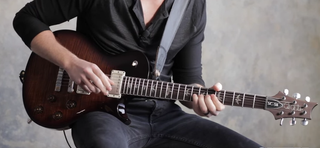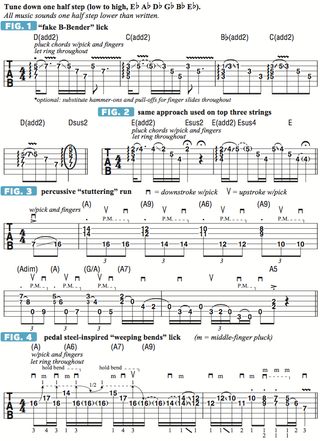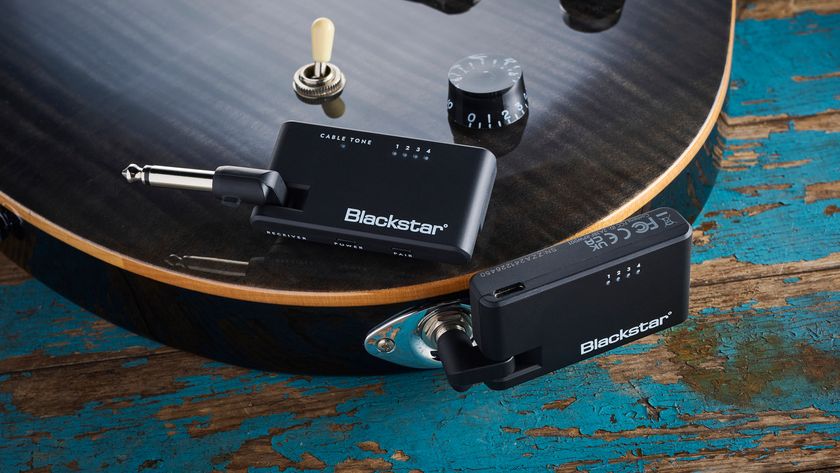Adapting Pedal Steel Licks to the Electric Guitar — Video

One of the things I love about country guitar is the way its vocabulary has, over the past 60-plus years, been influenced by the rich lexicon of licks invented by pedal-steel players. This month, I’d like to show you a few cool pedal-steel-like licks and playing approaches I’ve picked up over the years.
For those unfamiliar with the pedal steel, it’s an electric stringed instrument (typically sporting 10 to 14 strings) that’s played in a manner not unlike a fingerpicked slide guitar—with high action and configured to some kind of open tuning chosen by the player. Unlike a standard guitar, a pedal steel lays flat in front of you, like a bench or table with legs.
The steel is a smooth, solid metal bar that you hold in your fretting hand and glide along the strings to raise and lower their pitches (and wiggle to produce vibrato) as your other hand picks the strings with a thumbpick and fingerpicks. A mechanical system of foot pedals and knee-operated levers allows the player to stretch or slacken individual strings to raise or lower their pitches to specific pre-set intervals, such as a half step or whole step, which offers the player the ability to craft harmonically complex riffs that feature smoothly and precisely “bent” notes within chords.
The pedal steel is one of the most recognizable and characteristic instruments in country music, and emulating its sweetly “weeping” sound is an ambitious but fun challenge for electric guitarists.
Some guitars are equipped with a mechanical “B-Bender” or a “G-Bender,” which allows the player to likewise raise the pitch of one string (either the B or G) up a whole step by pushing or pulling the guitar’s neck, body or bridge. I don’t own one of those devices. In- stead, like many guitarists, I’ve come up with ways to emulate that kind of chord-bending sound using conventional playing techniques, such as finger slides.
You can see examples in FIGURES 1 and 2, for which I slide my index finger up two frets while holding down other notes of a major triad on adjacent lower strings. This technique takes practice, as you have to get used to forming chords differently, with your fingers crammed together at the same fret. (If you’re having trouble with the slides, substitute hammer-ons and pull-offs.)
Pedal-steel players are also sophisticated with their pick-hand articulation and rhythmic phrasing, and you’ll often hear them nimbly fingerpick palm-muted, percussive “stuttering” runs like this (see FIGURE 3), for which I use hybrid picking (pick-and-fingers technique) on guitar. The technique is kind of like a banjo roll, and you’ll need to train your pick and fingers to move in a flowing sequence. FIGURE 4 incorporates some chicken pickin’ and what are known as oblique bends within chord shapes to imitate the steel’s footpedal or knee-lever pitch-shifting action. Be sure to follow the left- and right-hand fingerings indicated with the tab.
To cop the sound of a pedal steel, it helps to emulate that instrument’s clear, round, bell- like tone. Dial in a clean tube-amp setting with reverb and perhaps some delay and compression. Use your guitar’s neck and bridge pickups together to get both warmth and “twang.” Steel players also typically employ a volume pedal to create swells, and reverb and delay really help smooth out that effect.

Get The Pick Newsletter
All the latest guitar news, interviews, lessons, reviews, deals and more, direct to your inbox!

“When I saw it, I couldn’t believe how cool it was”: Joe Satriani is selling one of his rarest guitars – an ultra-ambitious Ibanez Y2K Crystal Planet prototype

“They’re basically Les Paul copies, let’s be frank. It’s a Les Paul-style guitar and I already have amazing Les Pauls”: Kirk Hammett owns over 100 guitars but none of them are PRS. He explains why

